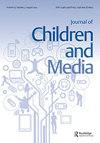Early vocabulary size in Argentinean toddlers: associations with home literacy and screen media exposure
IF 2.1
3区 心理学
Q2 COMMUNICATION
引用次数: 5
Abstract
ABSTRACT The objective of the following study was to analyze the associations of caregivers’ literacy practices and beliefs, and children exposure to screen media with lexical density and syntax development during the first three years. A total of 136 primary caregivers of infants between 12 to 40 months of age (M= 26.34, SD = 7.55) were evaluated. The participants completed a sociodemographic questionnaire, a reading comprehension test, a literacy practices and beliefs survey and the CDI (McArthur Bates Communicative Development Inventory) part II (words and sentences). In addition, children’s daycare attendance was considered. After controlling for age, gender, parent’s education level and daycare attendance, positive attitudes towards literacy and frequency of PC use contributed to CDI vocabulary scores, while shared reading frequency was associated with CDI syntax scores. These results indicate that both parent-child shared reading and PC use provide a context for verbal interaction and joint attention that stimulates language development. Impact Summary Prior State of Knowledge: There are contradictory results about the relations between home literacy, screen media exposure and language development during the first years of life. Also, most of this research has been conducted in WEIRD countries. Novel Contributions: Parents attitudes about reading and shared reading were more important in explaining language development than books quantity, caregiver’s reading comprehension and self-reading practices. Regarding screen exposure, only frequency of PC use was a significant predictor of children’s vocabulary scores. Practical Implications: The positive associations of literacy beliefs, practices and screen times with vocabulary might indicate that both shared reading and screen coviewing provide a context for parent-child joint attention and verbal interaction that promotes word learning.阿根廷幼儿早期词汇量:与家庭识字率和屏幕媒体曝光率的关系
摘要以下研究的目的是分析前三年照顾者的识字实践和信念,以及儿童接触屏幕媒体与词汇密度和句法发展的关系。对136名12至40个月大婴儿的主要照顾者(M=26.34,SD=7.55)进行了评估。参与者完成了社会人口学问卷、阅读理解测试、识字实践和信念调查以及CDI(McArthur-Bates交际发展量表)第二部分(单词和句子)。此外,还考虑了儿童日托的出勤率。在控制了年龄、性别、父母的教育水平和日托出勤率后,对识字的积极态度和电脑使用频率有助于CDI词汇得分,而共同阅读频率与CDI语法得分相关。这些结果表明,亲子共享阅读和电脑使用都为言语互动和共同注意提供了刺激语言发展的环境。影响总结先前的知识状态:关于家庭识字率、屏幕媒体曝光率和生命最初几年的语言发展之间的关系,存在着矛盾的结果。此外,这项研究大多在WEIRD国家进行。新颖贡献:父母对阅读和共同阅读的态度在解释语言发展方面比书籍数量、照顾者的阅读理解和自我阅读实践更重要。关于屏幕暴露,只有电脑使用频率是儿童词汇得分的重要预测因素。实际意义:识字信念、实践和屏幕时间与词汇的积极关联可能表明,共享阅读和屏幕浏览都为亲子共同关注和言语互动提供了一个环境,促进了单词学习。
本文章由计算机程序翻译,如有差异,请以英文原文为准。
求助全文
约1分钟内获得全文
求助全文

 求助内容:
求助内容: 应助结果提醒方式:
应助结果提醒方式:


